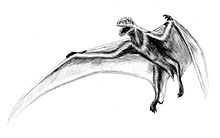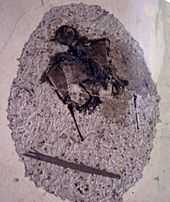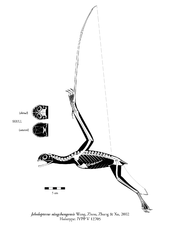Jeholopterus
| Jeholopterus Temporal range: Middle or Late Jurassic, 164Ma | |
|---|---|
 | |
| Fossil specimen (IVPP V 12705) | |
| Scientific classification | |
| Kingdom: | Animalia |
| Phylum: | Chordata |
| Order: | †Pterosauria |
| Family: | †Anurognathidae |
| Genus: | †Jeholopterus Wang et al., 2002 |
| Type species | |
| †Jeholopterus ninchengensis Wang et al., 2002 | |
Jeholopterus was a small anurognathid pterosaur from the Daohugou Beds of northeastern China (of uncertain age, probably Middle or Late Jurassic), between 168 and 152 million years ago[1]), preserved with hair and skin remains.
Naming
The genus was named in 2002 by Wang Xiaolin, Zhou Zhonghe and Xu Xing. The type species, the only known, is Jeholopterus ninchengensis. The genus name is derived from its place of discovery, Jehol in China, and a Latinised Greek pteron, "wing". The specific name refers to Nincheng County.
Description

The type species is based on holotype IVPP V12705, a nearly complete specimen from the Daohugou beds of Ningcheng County in the Neimongol (Inner Mongolia) Autonomous Region of China.[2] The specimen is crushed into a slab and counterslab pair, so that parts of the specimen are preserved on one side of a split stone and some on the other. This includes exquisite preservation of carbonized skin fibers and, arguably, "hair" or "protofeathers." The fibers are preserved around the body of the specimen in a "halo." Wing tissue is preserved, though its extent is debatable, including the exact points of attachment to the legs (or if it is attached to the legs at all). In 2009 Alexander Kellner published a study reporting the presence of three layers of fibers in the wing, allowing the animal to precisely adapt the wing profile.[3]
As an anurognathid, Jeholopterus shows the skull form typical for this group, being wider than it was long (28 mm), with a very broad mouth. Most teeth are small and peg-like, but some are longer and recurved. The neck was short with seven or eight cervical vertebrae. Twelve or thirteen dorsal vertebrae are present and three sacrals. There are five pairs of belly ribs. The tail vertebrae have not been preserved. The describers argue that Jeholopterus had a short tail, a feature seen in other anurognathids but unusual for "rhamphorhynchoid" (i.e. basal) pterosaurs that typically have a long tail. Wang et al. cited the presence of a fringe of hair in the region of the tail to infer the presence of a short tail. However, a subsequent study by Dalla Vecchia argued that gleaning any information about the tail is impossible, given that the tail is "totally absent" in the fossil.[4]

The wing bones are robust. The metacarpals are very short. A short pteroid, supporting a propatagium, is pointing towards the body. The hand claws are long and curved. The wings of Jeholopterus show evidence that they attached to the ankle, according to Wang et al.. They are relatively elongated with a wingspan of ninety centimetres.
The legs are short but robust. The toes bear well-developed curved claws, but these are not as long as the hand claws. The fifth toe is elongated, according to the authors supporting a membrane between the legs, the uropatagium.
Phylogeny
Jeholopterus was by the authors assigned to the Anurognathidae. In 2003 a cladistic analysis by Kellner found it to be a member, together with Dendrorhynchoides and Batrachognathus of an anurognathid clade Asiaticognathidae. An analysis by Lü Junchang in 2006 resolved its position as being the sister taxon of Batrachognathus.
Lifestyle
Anurognathids are normally considered insectivores. Wang e.a. hypothesised that Jeholopterus, being the largest species known of the group, might also have been a piscivore, a fish-eater.
Alternative interpretations


Though he never examined the fossil himself, advertising artist David Peters has popularized his idiosyncratic opinions about Jeholopterus and other pterosaurs widely on the internet. In general he finds and illustrates hosts of ornamental features and even multiple embryos although no other researchers have ever confirmed his findings. By manipulating downloaded images of Jeholopterus in the computer art program Photoshop, David Peters (2003) reported that he discovered an unusual suite of soft-tissue remains, including a horse-like tail Peters speculated may have been used as a fly sweeper/distractor, as well as a long fly lure (similar to that of the anglerfish) protruding from the head, and a fin or series of fins along the back. Peters also reported that he had found "rattlesnake-like fangs", and these, along with what he described as a rattle-snake-like mandible, buttressed palate, "surgically sharp" unguals, robust limbs and other characters suggested that Jeholopterus was a vampire pterosaur adapted to plunging fangs into tough hide, then rotating the skull forward locking the fangs beneath the hide to improve adhesion. The small teeth of the lower jaw would not have penetrated but squeezed the wound like a pliers.[5] Prominent pterosaur researcher Chris Bennett has described Peters' findings as "fantasy" and has vehemently denounced his methodology,[6] as has palaeozoologist Darren Naish.[7]
See also
References
- ↑ Liu, Y., Liu, Y., Ji, S., and Yang, Z. (2006) "U-Pb zircon age for the Daohugou Biota at Ningcheng of Inner Mongolia and comments on related issues" Chinese Science Bulletin, 51(21): 2634-2644. doi:10.1007/s11434-006-2165-2
- ↑ Wang, X., Zhou, Z., Zhang, F., and Xu, X. (2002). "A nearly completely articulated rhamphorhynchoid pterosaur with exceptionally well-preserved wing membranes and 'hairs' from Inner Mongolia, northeast China." Chinese Science Bulletin 47(3), 226 – 232.
- ↑ Alexander W. A. Kellner, Xiaolin Wang, Helmut Tischlinger, Diogenes de Almeida Campos, David W. E. Hone, and Xi Meng. (2009). "The soft tissue of Jeholopterus (Pterosauria, Anurognathidae, Batrachognathinae) and the structure of the pterosaur wing membrane", Proc. R. Soc. B doi:10.1098/rspb.2009.0846
- ↑ Dalla Vecchia, F.M. (2002). "Observations on the non-pterodactyloid pterosaur Jeholopterus ningchengensis from the Early Cretaceous of Northeastern China." Natura Nascosta, 24: 8 - 27.
- ↑ Peters, D. (2003). "The Chinese vampire and other overlooked pterosaur ptreasures." Journal of Vertebrate Paleontology, 23(3): 87A.
- ↑ Bennett, S. C. (2005). "Pterosaur Science or Pterosaur Fantasy." Prehistoric Times, No. 70, pp. 21-23 & 40.
- ↑ http://blogs.scientificamerican.com/tetrapod-zoology/2012/07/03/world-must-ignore-reptileevolution-com/
External links
- Discussion of the validity and uses of computer tracing techniques, from the Dinosaur Mailing List